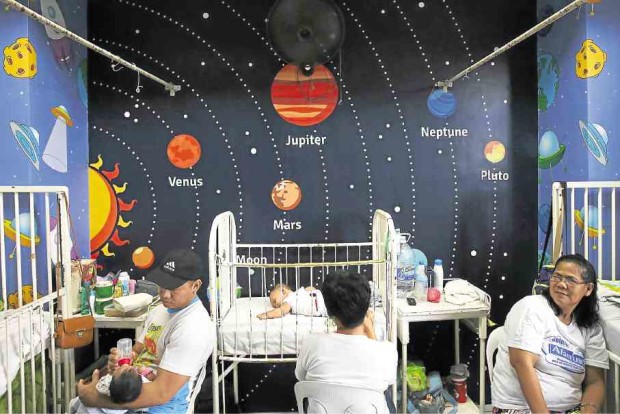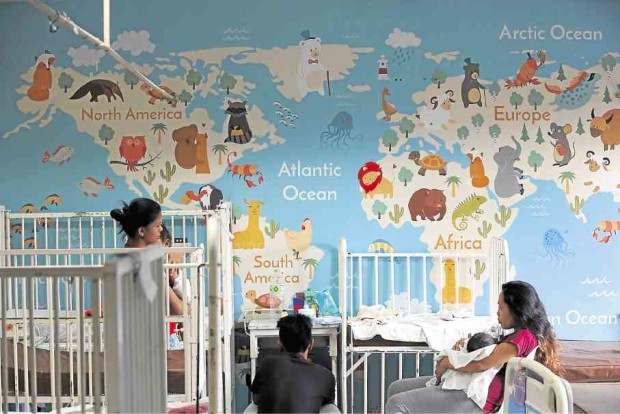Children’s Hospital goes from ‘painful white’ to playful walls

CHEERY MAKEOVER Five wards of the National Children’s Hospital in Quezon City have been made brighter by a private donor in time for NCH’s 71st anniversary.—NIÑO JESUS ORBETA
For 3-month-old “Jason,” his little bed at National Children’s Hospital (NCH) in Quezon City has been a second home.
And if the newly redesigned walls could talk, they would tell the baby: “Tahan na (Cry no more).”
To better care for patients like Jason, a boy with Down’s syndrome who has been in and out of NCH due to recurring problems caused by a hole in his heart, the government-run hospital recently received a private sector donation that transformed its white, bare-looking wards into warm, playful rooms.
The idea was to replace the sterile hospital look with splashes of color that can help ailing infants and toddlers—
and their parents—cope with the daily discomforts, the needle pricks and the cold feel of metal cribs, that come with their treatment.
NCH chief Dr. Epifania Simbul said the makeover was a much welcome change to mark the hospital’s 71st founding anniversary, which is being celebrated this month.
Article continues after this advertisement“Imagine, here is a hospital where everything is white, including doctors who also wear white,” she said in a program last week, drawing smiles from fellow physicians. “With this redesign, we can help (our patients) erase the memory of a painful white room.”
Article continues after this advertisementWhen the Inquirer saw him recently, Jason shared the ward with at least four other children also battling respiratory illnesses. One room has been turned into a window to the solar system, another came alive with drawings of jungle animals, while smiling, googly-eyed fruits and vegetables keep the kids company in the next.
The redesign was courtesy of a company, Norde International Distributors, which has chosen NCH as a beneficiary.
“Public hospitals have less funding and facilities are sometimes not maintained that well. And unlike other public hospitals, NCH focuses on children with sensitive cases,” the company said in a statement. “We feel that livening up the walls and rooms would provide an improved experience for the patients and their families.”
Environment-friendly
Walls with lively designs are actually nothing new at the hospital, which earlier had volunteers repainting its corridors.
But the latest project— which covers five wards—introduced the use of environ ment-friendly HP Latex Inks on the walls. According to Norde, the special ink makes use of water-based printing technology that is safe for sensitive indoor conditions. The children did not even have to leave their rooms when the walls were being redone.
“This is why private donations, both from individuals and corporations, are really significant for us,” Simbul said. “We are looking for help everywhere.”
Established in 1945 (as a hospital originally catering to war veterans), the NCH remains a place of hope, especially for the poor. Currently with a 250-bed capacity, 90 percent of its patients are indigent.
The respiratory ward receives the highest number of admissions, mostly children suffering from pneumonia, asthma and bronchitis, and requiring care for days or even years.
Jason’s mother, Jocelyn, is one of the grateful parents who found succor at NCH at minimal cost. “We were recommended for treatment here by the Navotas hospital because they couldn’t attend to my son’s needs,” the 42-year-old seamstress said. “Now every time Jason is sick, we bring him here.”
Jocelyn hopes to have her son’s heart operation at NCH as well, where cardiologists have been monitoring his progress. “I will not give up on him, he is my son!” she said with a smile that reflected the new cheerful look of Jason’s ward.
